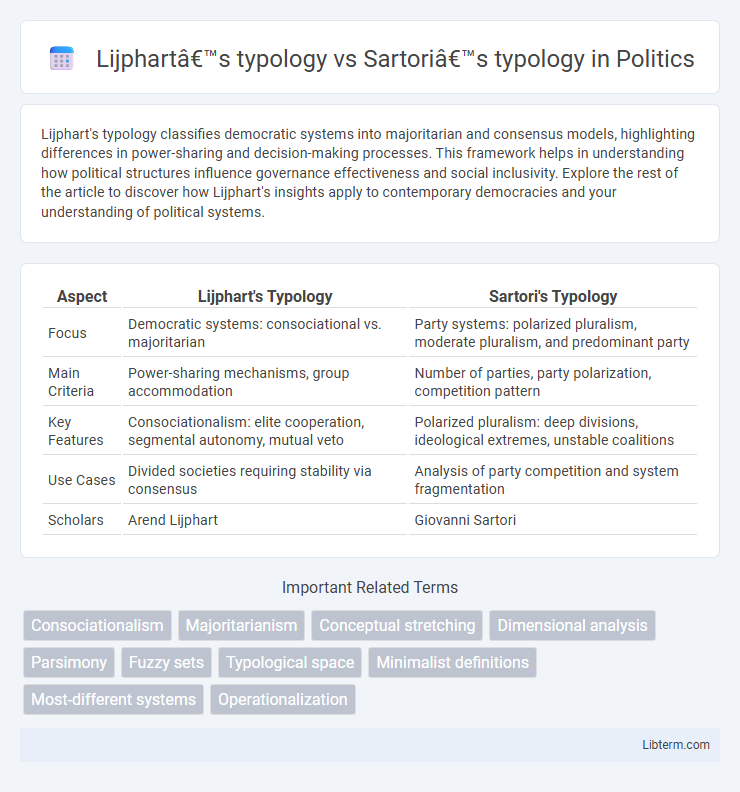Lijphart's typology classifies democratic systems into majoritarian and consensus models, highlighting differences in power-sharing and decision-making processes. This framework helps in understanding how political structures influence governance effectiveness and social inclusivity. Explore the rest of the article to discover how Lijphart's insights apply to contemporary democracies and your understanding of political systems.
Table of Comparison
| Aspect | Lijphart's Typology | Sartori's Typology |
|---|---|---|
| Focus | Democratic systems: consociational vs. majoritarian | Party systems: polarized pluralism, moderate pluralism, and predominant party |
| Main Criteria | Power-sharing mechanisms, group accommodation | Number of parties, party polarization, competition pattern |
| Key Features | Consociationalism: elite cooperation, segmental autonomy, mutual veto | Polarized pluralism: deep divisions, ideological extremes, unstable coalitions |
| Use Cases | Divided societies requiring stability via consensus | Analysis of party competition and system fragmentation |
| Scholars | Arend Lijphart | Giovanni Sartori |
Introduction to Typology in Political Science
Lijphart's typology classifies political systems based on variables such as executive-legislative relations and party systems, emphasizing patterns of democracy and consensus versus majoritarian governance. Sartori's typology, on the other hand, concentrates on party systems by categorizing them through the number of effective parties and their interactions, providing a framework for understanding political competition. Both typologies serve as foundational tools in political science for systematically comparing and analyzing the diversity of political institutions and party dynamics.
Overview of Lijphart’s Typology
Lijphart's typology categorizes democracies into majoritarian and consensus models, emphasizing how power is distributed and how decision-making processes operate within different political systems. This framework highlights variables such as executive-legislative relations, electoral systems, and party structures to distinguish between the concentration of power in majority rule and the dispersion of power in consensus-based governance. Compared to Sartori's typology, which focuses more on party systems and their ideological dimensions, Lijphart provides a broader institutional analysis of democratic design and functioning.
Overview of Sartori’s Typology
Sartori's typology categorizes political parties based on their ideological distance and organizational structure, emphasizing the role of polarized pluralism and programmatic cleavages. It distinguishes between moderate and polarized parties, highlighting the impact of extremist elements on party systems and democratic stability. This approach contrasts with Lijphart's focus on consociationalism and power-sharing mechanisms in plural societies.
Fundamental Differences Between Lijphart and Sartori
Lijphart's typology emphasizes consensus versus majoritarian democracies based on patterns of power-sharing and institutional arrangements, while Sartori's typology focuses on party systems categorized by their structural characteristics such as the number and ideological distance of parties. The fundamental difference lies in Lijphart's institutional approach prioritizing governance style and inclusivity, contrasting with Sartori's analytical framework centered on party competition dynamics and system fragmentation. Lijphart analyzes democratic stability through mechanisms like coalition governments, whereas Sartori highlights the impact of party polarization and system fragmentation on political stability.
Methodological Approaches: Lijphart vs Sartori
Lijphart's typology employs a consensus vs. majoritarian framework using qualitative comparative analysis to categorize democracies based on power-sharing and institutional designs. Sartori's typology, grounded in an analytic and inductive method, emphasizes conceptual clarity and operational definitions for classifying party systems and political phenomena. Both approaches prioritize rigorous methodological precision, yet Lijphart leans toward normative institutional assessment while Sartori focuses on empirical and conceptual rigor in political classification.
Application in Comparative Politics
Lijphart's typology distinguishes between majoritarian and consensus democracies, providing a framework to analyze governmental structures, electoral systems, and policy outcomes in comparative politics. Sartori's typology focuses on party systems, categorizing them based on party number, polarization, and competition patterns to explain political stability and party behavior. Both typologies are essential for examining democratic performance, institutional design, and party dynamics across diverse political systems.
Strengths and Weaknesses of Lijphart’s Typology
Lijphart's typology excels in its clear distinction between majoritarian and consensus democracies, offering a practical framework for comparative analysis of political systems based on executive-legislative relations, party systems, and electoral rules. Its strength lies in emphasizing institutional design's role in promoting political stability and inclusiveness, especially in divided societies. However, its weaknesses include an oversimplified binary classification that may overlook hybrid models and evolving democratic practices, as well as insufficient attention to cultural and historical contexts influencing democratic functioning.
Strengths and Weaknesses of Sartori’s Typology
Sartori's typology excels in its analytical rigor and precise classification criteria, allowing for clearer distinctions between party systems based on the number of relevant parties and their interactions. Its strength lies in operational clarity and the ability to predict party system stability or fragmentation, though it struggles with overly rigid categories that may not capture fluid political dynamics. This rigidity often limits its adaptability to complex or evolving party systems, reducing its explanatory power in cases of emerging or hybrid political landscapes.
Case Studies Illustrating Both Typologies
Case studies illustrating Lijphart's typology often include consociational democracies like Belgium and Switzerland, where power-sharing mechanisms and segmental autonomy exemplify his focus on plural societies. Sartori's typology is commonly demonstrated through party systems in Italy and Spain, highlighting polarized pluralism and the dynamics of party competition. Comparative analyses reveal how Lijphart's emphasis on institutional arrangements contrasts with Sartori's focus on party system structures and interactions in diverse political environments.
Conclusion: Relevance in Modern Political Analysis
Lijphart's typology prioritizes consensus and majoritarian democracy models, offering practical frameworks for analyzing diverse political systems through power-sharing and institutional designs. Sartori's typology emphasizes the classification of party systems based on fragmentation and polarization, providing critical insights into party competition and electoral dynamics. Both typologies remain relevant in modern political analysis by addressing different dimensions: Lijphart for governance structure effectiveness and Sartori for party system behavior and electoral volatility.
Lijphart’s typology Infographic

 libterm.com
libterm.com